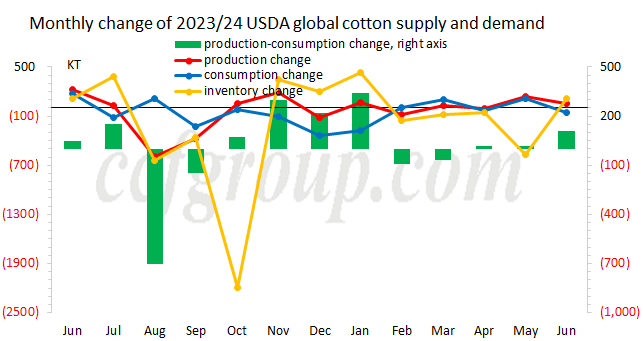Interpretation of USDA's Jun supply and demand report on cotton
1. USDA forecasts a higher 2023/24 production and ending stock in Jun
The United States Department of Agriculture (USDA) released the global cotton supply and demand balance sheet for June, making minor adjustments by slightly increasing the cotton production and ending stocks for the 2023/24 season, while slightly decreasing consumption. Specifically, beginning stocks were raised by 50,000 tons, ending stocks by 110,000 tons, with production seeing a minor increase of 50,000 tons and consumption down by 60,000 tons. Notably, Indian cotton production was adjusted up by 40,000 tons, and for ending stocks, U.S.'s stocks increased by 100,000 tons. Overall, U.S. cotton export sales for current crop year are nearing completion.

2. USDA adjusts production upwards for 2024/25
Compared to the previous month's data, the new balance sheet for the upcoming crop year showed a slight increase in production and ending stocks. While U.S. production forecast remained unchanged, recent planting data indicated faster growth compared to the previous year, alongside a notable 5% decline in crop good-to-excellent quality, which was a bearish factor for mid-term ICE cotton. Furthermore, ending stocks for both the U.S. and Brazil has increased compared to the previous season, with global ending stock expectations rising by 550,000 tons and global production significantly increasing by 1.17 million tons. Coupled with technical analysis, the outlook for ICE cotton suggests further downside potential.
Overall, despite modest adjustments to data for the current and upcoming crop years by USDA in June, expectations of loose supply due to significant production increases for 2024/25 continue to overshadow ICE cotton. Meanwhile, ongoing weak downstream demand in China, relatively high cotton import stocks at ports, and no confirmed news about the allocation of sliding-scale duty quotas have significantly undermined market confidence. Unless significant bullish factors emerge to reverse the downward trend, the medium-term outlook indicates a continued weakening of cotton prices both domestically and internationally.
- Top keywords
- Cotton Price
- Cotton Futures Price
- Cotton Futures
- CZCE
- PTA Futures Price
- Chemical Fiber
- Polyester Prices
- Wool price
- PTA Futures
- Shengze Silk
- China
- Yarn Price
- price
- China Textile City
- Fibre Price
- Benzene Price
- Cotton
- Index
- Cotton Index
- PTA
- fabric price
- NYMEX
- Top 10
- textile industry
- Spot Cotton
- Cotton Yarn
- Polyester Price
- Futures
- PTA Price
- cotton yarn price

